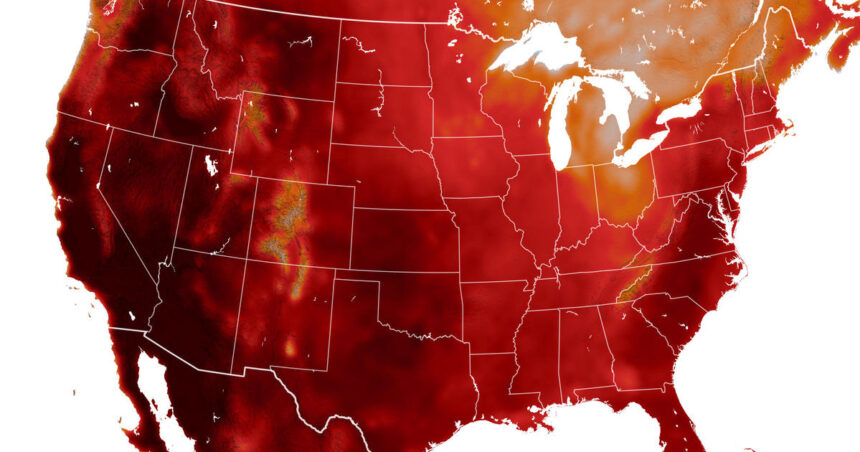The US has been grappling with persistently hot temperatures this summer, and a map from NASA illustrates the scale of these persistent heat waves.
The map, which consists of images of the national temperature for July 10, used satellite images – together with a complex mathematical model known as the Goddard Earth Observing System – to create a kind of color code, with dark red indicating areas that reached a height of 104 degrees Fahrenheit, according to NASA Earth Observatory, a program that examines the impacts of climate change.
The results are overwhelming, showing temperatures that could be dangerous in almost the entire continental U.S. Southwest is experiencing heat, according to the map, with almost all regions experiencing triple-digit highs.
NASA Earth Observatory image
On the day the map was released, Las Vegas set a daily record of 118 degrees, which also marked the fifth straight day of temperatures of 115 degrees or higher. record well, according to the National Weather Service.
Just three days earlier, California’s famous Death Valley reached 129 degrees on July 7, the National Park Service reported, just five degrees off the all-time world record of 134 degrees, set in 1913.
And on July 6, a Death Valley motorcyclist died of heatstroke as temperatures reached 128 degrees, according to the National Park Service, and four other motorcyclists from his group were hospitalized. Officials told CBS News in a statement that it was too hot for park rangers to call for a helicopter to lift him up.
NASA Earth Observatory image
The rest of the US doesn’t look much better. Oregon officials reported five heat-related deaths statewide on July 10, according to CBS affiliate KOIN, and at least 17 since July 5.
And after tearing through the Caribbean, causing massive damage and destruction, Hurricane Beryl made landfall in southeast Texas on July 8, knocking out power to more than three million customers in the Houston area. Millions remain without power for a few days in the middle of the searing temperature that saw the heat index – which measures what the temperature feels like for the human body, taking into account the humidity – above 100 degrees.
The heat, meanwhile, shows no signs of abating this week, especially in the Northeast. It was Tuesday expected to be one of the hottest days of the year so far for New York City, with a heat index well above 100. Mayor Eric Adams on Monday advise low-income residents to apply for free air conditioning through the federal Home Energy Assistance Program.
Boston also experienced some days in the high 90s, and according to CBS Boston meteorologist Terry Eliasen, the city. is at a pace for one of the hottest and wettest Julys on record.
Washington, DC, reached 104 degrees Tuesday, each weather service. According to CBS affiliate WUSA, which set the daily record in 1988. It also marked the third time triple-digit temperatures have been recorded for the nation’s capital.
According to the latest National Weather Service forecast, a heat watch and severe weather warning is in effect Tuesday for parts of the Pacific Northwest, the Southern Plains, the Middle and Lower Mississippi Valley, the Ohio and Tennessee valleys and the Central Gulf Coast.
“Extremely dangerous and deadly heat, especially for urban areas on the Southeast and East Coasts, is forecast” through Wednesday, the weather service said.






